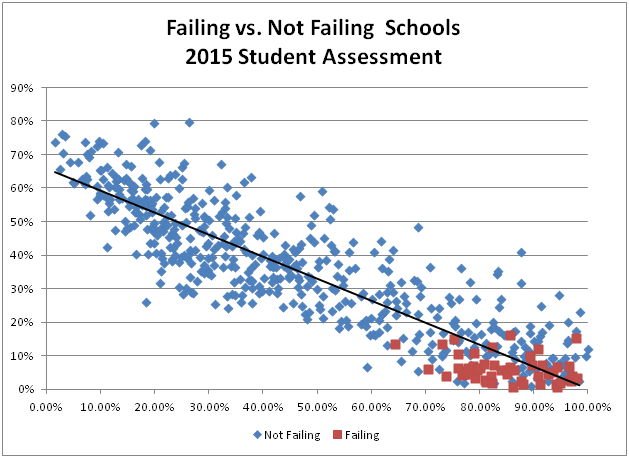For the past several years, Governor Cuomo’s office has issued a report, “The State of New York’s Failing Schools.” The 2015 report contends that “Despite the fact that districts with failing schools receive more state funding than other districts, these schools are delivering unacceptable results…The statistics and facts contained in this report and its Appendix expose a public education system badly in need of change.” The report identifies 178 schools, 69 of which are located upstate, that have been identified as “failing.” The report identifies several ways in which the “failing” schools perform poorly. According to the report, these schools are among the worst performing in the state in ELA (English Language Arts) and mathematics performance, or have graduation rates of less than 60%. The report goes on to state, “Of the 178 schools, 77 have been failing for a decade. More than 250,000 students have passed through these 77 schools in the past ten years. That represents 250,000 students who did not have access to the high quality public education that they deserved. Moreover we are failing the kids who need us most. Ninety three percent of students in failing schools are students of color and 82 percent of these students are eligible for free or reduced price lunch.”
The report goes on to state, “Of the 178 schools, 77 have been failing for a decade. More than 250,000 students have passed through these 77 schools in the past ten years. That represents 250,000 students who did not have access to the high quality public education that they deserved. Moreover we are failing the kids who need us most. Ninety three percent of students in failing schools are students of color and 82 percent of these students are eligible for free or reduced price lunch.”
The report benchmarks the “failing” schools against average schools throughout the state, even though the students at the failing schools do not have the same backgrounds and advantages. The “failing” schools are concentrated in communities with high levels of poverty. And, high concentrations of poverty are strongly associated with poor student performance. My post, “What Critics of Central City Schools Ignore” shows that 79% of the variation in performance between schools in upstate metropolitan counties is accounted for by the percentage of economically disadvantaged students attending them. Given that fact, it is worth examining how well students at the “failing” schools do on the Statewide Assessment compared with students at other schools with similar concentrations of disadvantaged students.
The chart below shows that students at the “failing” schools did badly on the exam. On average, only six percent of the students passed. But, note that students at other schools with high concentrations of disadvantaged students did poorly as well – in fact the average performance at the similar schools that were not labeled “failing” was only 9.8% – only 3.8% better than students at the “failing” schools. And, note that the classification scheme is inconsistent with the performance of schools on this year’s test. A number of the “failing” schools were at or above the average performance of all schools having similar concentrations of disadvantaged students. The reality is that almost all schools with high percentages of disadvantaged students had very low passing rates.

Disadvantaged students face challenges not faced by students in privileged communities- they often come from single parent families, their parents are often poorly educated, they may not be native English speakers, and they may face discrimination as minority group members. Because of these factors, it is not surprising that students at schools with high concentrations of economically disadvantaged students do not do well on statewide exams.
Throughout the report, there is an emphasis on the notion that the remedy for the problem of poor student performance in central city schools is to find more competent teachers and administrators. In another part of the report, the authors argue, “It is incongruous that 99% of teachers were rated effective, while only 35.8% of our students are proficient in math and 31.4$ in English language arts. How can so many of our teachers be succeeding when so many of our students are struggling?” To remedy these problems, the governor proposes reforms to “teacher preparation, certification, evaluation and tenure and the transformation of our failing schools. Our students deserve nothing less.” To transform the “failing” schools, he proposes close supervision and replacing school management, in some cases. The Albany Times-Union reports, “State receivership would allow the state Education Department to appoint a person or organization like a charter school or nonprofit to come in and reorganize a district school without the oversight of the school board, superintendent or other administrators.”
But the report’s emphasis on the failings of the so-called “failing” schools is misplaced The major causes of poor central city school performance lie outside the classroom. Addressing school performance without remedying the problem that is the primary contributor to poor student performance — poverty — is unlikely to significantly improve it.
The report stigmatizes city schools as “failing,” with the implication that if they were run better, or if their teachers were more competent, that students would perform significantly better. The “Failing Schools” program risks damaging schools by attributing power to them that they do not have, alienating faculty and damaging reputations. A more realistic approach would recognize the challenges faced by central city schools, and address them in the context of their socioeconomic environments, by focusing on combating poverty in our central cities .